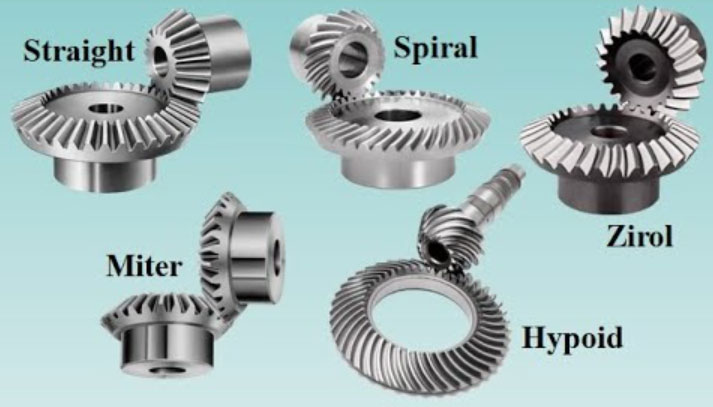Bevel gears are a type of gears with intersecting axes that have conically shaped teeth. They are widely used in various applications, such as automotive transmissions, industrial machinery, and aerospace systems. The manufacturing of bevel gears involves several processes that are aimed at producing high-quality gears with precise dimensions and excellent performance characteristics. In this in-depth analysis, we will discuss the key manufacturing processes involved in producing bevel gears.

- Design and Engineering: The manufacturing process of bevel gears begins with the design and engineering phase. The gear geometry, tooth profile, pitch, and other specifications are determined based on the intended application and load requirements. Computer-aided design (CAD) software is typically used to create a 3D model of the gear, allowing for precise control over the gear’s dimensions and tooth profiles.
- Gear Cutting: Gear cutting is a crucial process in bevel gear manufacturing that involves removing material from a blank to form the gear teeth. There are several methods for cutting bevel gears, including:a. Conventional Gear Cutting: In this method, a gear hob or a gear shaper is used to remove material from the gear blank. The hob or shaper has cutting teeth that gradually shape the teeth of the bevel gear. This process is suitable for low to medium production volumes.b. CNC Gear Cutting: Computer Numerical Control (CNC) machines equipped with special gear cutting tools can be used to cut bevel gears. CNC gear cutting offers high precision and flexibility in terms of gear profiles and tooth geometries. It is ideal for high-volume production and complex gear designs.c. Gear Grinding: Gear grinding is a precision machining process that provides excellent surface finish and dimensional accuracy. It is often used for high-quality bevel gears where tight tolerances and low noise levels are required. Gear grinding can be performed using both conventional and CNC machines.
- Heat Treatment: Heat treatment is a critical step in bevel gear manufacturing to enhance the gear’s hardness, durability, and resistance to wear. The most common heat treatment process for bevel gears is carburizing, where the gear is exposed to a carbon-rich environment at high temperatures. This causes carbon atoms to diffuse into the gear’s surface, creating a hardened layer known as the case. After carburizing, the gear is quenched and tempered to achieve the desired hardness and strength.
- Finishing Operations: After the gear cutting and heat treatment processes, various finishing operations are performed to improve the gear’s surface quality, accuracy, and noise characteristics. These operations may include:a. Gear Deburring: Bevel gears often have burrs or sharp edges after the cutting process. Deburring removes these imperfections and smoothens the gear’s surface.b. Gear Lapping: Gear lapping is a precision machining process that improves the gear’s surface finish and tooth contact pattern. It involves mounting the gears on a lapping machine and using a fine abrasive paste to remove small amounts of material.c. Gear Inspection: Inspection is a crucial step to ensure the quality and accuracy of bevel gears. Various measurement techniques such as coordinate measuring machines (CMM), gear analyzers, and optical profilometers are used to inspect the gear’s dimensions, tooth profile, and surface finish.
- Assembly: Once the gears have undergone all the necessary manufacturing processes and inspections, they are ready for assembly. Bevel gears are typically assembled with other components such as shafts, bearings, and housings to form a complete gear system. Assembly may involve various techniques, including press-fitting, welding, or bolting, depending on the specific application.
- Quality Control: Throughout the entire manufacturing process, quality control is essential to ensure that the bevel gears meet the required specifications. This includes both in-process quality control and final inspection. During the manufacturing stages, dimensional checks, surface quality assessments, and hardness testing are performed to monitor the gear’s conformity to specifications. Final inspection involves comprehensive checks to verify the gear’s dimensional accuracy, tooth profile, surface finish, and other critical parameters. This ensures that only high-quality gears are released for use.
- Post-Manufacturing Processes: After the gears are manufactured, additional processes may be required depending on the specific application and customer requirements. These processes may include surface coating or plating for improved corrosion resistance, shot peening to enhance fatigue strength, or specialized treatments to achieve specific performance characteristics.
It is worth noting that the manufacturing processes for bevel gears can vary depending on factors such as gear size, material, precision requirements, and production volume. Advanced manufacturing technologies, such as 5-axis CNC machining, computerized simulation, and automation, have significantly improved the efficiency, precision, and repeatability of bevel gear manufacturing.
In conclusion, the manufacturing of bevel gears involves a series of processes, starting from design and engineering to cutting, heat treatment, finishing, assembly, and quality control. Each step contributes to the final quality, performance, and durability of the gears. By employing advanced machining techniques and rigorous quality control measures, manufacturers can produce high-quality bevel gears that meet the demanding requirements of various industries.
